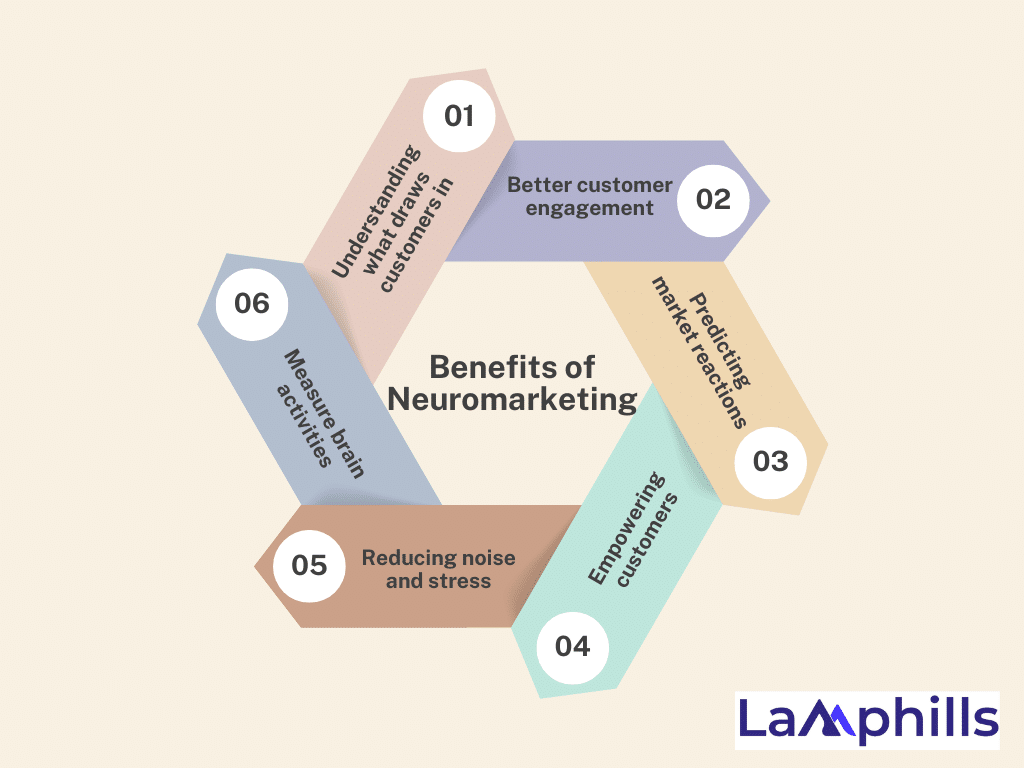Have you ever wondered what’s going on in your customers’ minds when they see your ads or pick your product off the shelf? Neuromarketing can give you the answers.
As a content creator, I’ve always been interested in why people make certain choices when they shop. A few years ago, I attended a marketing conference where a neuromarketing expert shared a fascinating story. He talked about a grocery store that used specific colors and smells to influence people’s purchases.
Just by switching the background music to something more energetic, they saw a 20% increase in sales of specific items. This got me hooked on neuromarketing—a field that uses brain science to understand how people react to different things in marketing.
By using brain science, businesses can better understand what makes people tick and how to influence their decisions. In this guide, we’ll break down everything you need to know about neuromarketing—what it is, how it works, and how it can help your business grow. Keep reading!
Key Points
- By using brain science, businesses can understand why people make certain buying choices, leading to more effective marketing strategies.
- Studies show that emotional connections with products influence buying decisions, making it essential for brands to create positive feelings.
- Most decisions are made without us even realizing it, as the unconscious mind plays a major role in shaping our behavior.
- This technique helps businesses see where customers focus, improving ads and product designs by understanding what draws their eyes.
- By understanding customer emotions through tools like EEG and eye-tracking, businesses can create more engaging and memorable experiences.
What is Neuromarketing?
Neuromarketing is a new branch of marketing that combines brain science, economics, and psychology. It measures brain activity and biological signals to understand customers’ thoughts, feelings, and decisions. This helps improve things like ads, packaging, product experience, and brand experience.
Neuromarketing goes beyond examining how well ads perform. It also shows how effective every part of the customer journey is, from the first time they see a brand to when they use a product again.
Thomas Zoëga Ramsøy states, “We don’t always make decisions rationally. Most of our choices are influenced by the unconscious.”
Neuromarketing uses tools like eye-tracking, brain scans (EEG), machine learning, and AI to measure and understand customer behavior. Since much of what drives consumer decisions happens unconsciously, understanding the brain can give better insights into why people act the way they do, leading to higher profits.
Here’s the Science Behind It
During my research, I found studies showing that emotions are a big part of making decisions. In one experiment, people who saw products with positive feelings attached to them were more likely to buy those products. This aligns with my experiences; I often feel attracted to brands that make me happy or nostalgic. The stronger the emotional connection, the more likely I am to buy.
What influences our decisions?
We often think we’re fully in control of our choices, but most of them are actually guided by our unconscious mind. This is where implicit cognition comes in—things that affect our choices without us even realizing it.
Our unconscious mind works in two ways:
1. The unconscious state: like when we are in a deep sleep or coma.
2. Unconscious processes: even when we’re awake, some mental processes happen without us being aware, but they still influence our thoughts, feelings, and actions.
In recent years, the term “nonconscious” has been used in market research, especially in the US. Whatever the term, our unconscious mind plays a big part in our decisions.
Benefits of Neuromarketing

Neuromarketing tools measure complex brain activities like attention, emotions, and memory, giving deeper insights that traditional methods can’t reach. Here are some key benefits:
1. Understanding what draws customers in: Neuromarketing helps identify which parts of an ad or product trigger positive or negative feelings by measuring emotions, giving businesses a clearer idea of what works.
2. Better customer engagement: When companies can measure and understand customer emotions, they can create more engaging experiences, making it easier to influence customer behavior.
3. Predicting market reactions: New tools, like predictive models, can now forecast how customers will react to ads, helping companies fine-tune their strategies using big data and artificial intelligence.
4. Empowering customers: Neuromarketing helps brands make the customer journey smoother by providing clear product information and reducing obstacles, making it easier for customers to make informed choices.
5. Reducing noise and stress: By making marketing efforts more efficient, neuromarketing cuts through the clutter, reducing wasted efforts and helping customers have a more enjoyable, stress-free experience with less confusion and annoyance.
The Neuromarketing Tools (Techniques)
Neuromarketing uses several tools to study how people react to marketing. Here are the main techniques:
#1. Eye-Tracking
Eye tracking measures where and how long people look at things. It can track:
- Time to first look
- How long do they focus
- How many times do they look
- The order of their focus
Eye tracking also detects emotions through changes in pupil size, which can indicate excitement. This helps businesses understand how people process visual content like ads.
There are three types of eye-tracking:
- Stationary infrared
- Glasses-based infrared
- Webcam-based (less accurate)
Eye-tracking is widely used because it’s easy to access and gives valuable insights into customer behavior. It’s often combined with other tools like brain scanning (EEG) for deeper analysis.
For example, a toy company used eye-tracking to see where kids looked first on the packaging. They noticed kids focused on the bright colors but missed the toy’s name, so they changed the design to make the name stand out more.
Eye-tracking heatmaps show where people focus most on an ad or product, helping marketers improve their designs.
#2. Brain Scanning (Electroencephalography or EEG)
EEG measures brain activity by detecting electrical signals in the brain. It helps researchers see how the brain reacts to things like ads.
EEG works by placing sensors on the scalp and tracking brain activity in real-time. It can show how emotions and thoughts change as people are exposed to marketing content. EEG is often used along with eye-tracking to get a full picture of how people react emotionally and mentally when looking at something.
By combining these tools, researchers can better understand customer reactions and emotions as they interact with ads and products.
#3. Facial Coding
Facial coding studies people’s facial expressions to understand their emotions. However, more experts are questioning its accuracy.
Unlike tools like eye-tracking or EEG, which give real-time data from the brain, facial coding can be biased, inconsistent, and may not truly reflect people’s real emotions. Because of this, big companies like Nielsen and Microsoft have stopped using facial coding in their advertising research, focusing instead on methods that are backed by more solid science.
#4. Functional Magnetic Resonance Imaging (fMRI)
fMRI is a brain scanning method used in neuromarketing to see which parts of the brain are active during different types of consumer behavior. It tracks both conscious and unconscious responses. While mostly used in academic research, fMRI helps scientists understand which areas of the brain respond to marketing.
The most common type is BOLD fMRI, which measures oxygen levels in the brain. When a brain region is more active, it gets more oxygen-rich blood. This method has also been used to study things like creativity.
#5. Physiological Measures
In neuromarketing, several physical measurements are used to understand how people react emotionally and mentally to ads and products. These include:
- Galvanic skin response: Measures changes in skin moisture to show how strong someone’s emotional reaction is.
- Pupil dilation: Tracks changes in pupil size to see how engaged or emotionally affected someone is.
- Heart rate: Can show levels of excitement or stress.
- Respiration: Measures breathing patterns to understand emotional responses.
6. Implicit Measures
Consumer behavior isn’t always based on clear thinking; it often involves automatic, unconscious reactions. New tools help study these hidden mental processes, and **Reaction Time (RT)** is one of the most used methods.
- Response Time (RT): This is how long it takes someone to respond to a task. It shows unconscious emotions and thought processes.
- Implicit Association Test (IAT): This test measures hidden biases or preferences people may have without realizing them. It is often used to study stereotypes.
- Fast Response Test (FRT): A method used to quickly measure unconscious thoughts and attitudes in people.
Each of these tools offers unique insights into how consumers think, feel, and respond to marketing, helping businesses create more effective campaigns.
Here is a simple checklist that will guide you through the key steps to use neuromarketing in your business to better connect with your audience and boost sales.
How is neuromarketing different from consumer neuroscience?
Neuromarketing is the business side of brain science, helping companies understand customer preferences and decisions. On the other hand, consumer neuroscience is an academic field combining psychology, neurology, and economics to study how the brain shapes consumer behavior.
Neuromarketing gives valuable insights into customers and the market, while consumer neuroscience helps us understand the deeper reasons behind consumer decisions.
Examples of Neuromarketing
There are simple neuromarketing ideas that anyone can use to improve conversion rates. Here are some of the most successful examples:
#1. Audio Branding
Branding isn’t just about visuals. Using sound is a powerful way to help customers remember your business. Ads with a catchy voice or music can quickly make people recognize your brand. Many big brands use audio logos, but the best ones are short and easy to remember. Audio branding works alongside your other branding efforts to create a clear picture in customers’ minds of who you are, what you do, and what you stand for.
#2. Colour Psychology
Colour psychology says using the right colors is important to catch a customer’s attention. For example, a common mistake is using pink or purple for a brand selling men’s clothing. This shows how important it is to choose the right colors when running a business.
#3. Effective Packaging
Neuromarketing can help improve packaging by focusing on both looks and function. Big brands like Campbell’s Soup, Frito-Lay, and Chips Ahoy use neuromarketing tools to make their packaging more appealing. By using eye-tracking and EEG (brain activity) data, companies can find out which design elements aren’t working for their customers.
For example, Nabisco found that people liked the resealable feature on Chips Ahoy packaging, but testing showed it actually triggered negative feelings. They realized the packaging was hard to read, and the cookie image seemed dull. So, they redesigned it to be clearer and made the cookie picture more exciting. Even small changes in packaging can make a big difference.
#4. The Wrong Font Can Harm Your Business – and Even Your Sales.
Choosing the right font is important in neuromarketing. Different fonts send different messages to the brain. Simple fonts, like sans-serif, are easy for the brain to understand quickly. Complex fonts, on the other hand, make the brain work harder to read and remember the information. Use simple fonts when your message needs must be clear, like instructions or a call to action. Complex fonts can grab attention but should only be used to highlight important details.
#5. Focus on the Senses
Sometimes a product feels different in your hands than you expect just by looking at it. Sensory branding appeals to your senses—sight, smell, sound, taste, and touch. Let’s focus on scent marketing. Scent marketing isn’t just about making a space smell nice. It’s about creating a unique scent that matches a company’s brand, message, and audience. A great example is Abercrombie & Fitch. This clothing brand was one of the first to use scent in their stores, creating their line of woody, intense fragrances that reflect their brand identity.
#6. Pricing
Price affects how much money a business makes. Neuromarketing has shown that using the right pricing strategy can make a big impact. Should prices be rounded or not? That’s a tricky question. Rounded prices are easier for the brain to understand, while odd prices make people think more. Businesses decide whether to appeal to emotions or logic in their ads, and research shows that the best pricing approach depends on which method they choose.
How is Neuromarketing Different from Traditional Marketing?
Traditional marketing methods focus on what people consciously think and say. They use tools like surveys, focus groups, and interviews to understand customer behavior.
However, these methods rely on what people report, which can miss the hidden, subconscious factors that influence their decisions.
Neuromarketing, on the other hand, measures deeper, real-time responses. It tracks how customers react subconsciously, providing a more accurate picture of how they truly respond to ads, messages, and customer experiences.
Famous Brands Using Neuromarketing
Companies use neuromarketing to learn how customers react to their ads, packaging, and campaigns. This helps businesses gather important information and test their ads before they go public.
Neuromarketing also helps brands understand what motivates customers and influences their decisions, which can increase sales and grow the business. Here are some examples of companies using neuromarketing:
#1. TikTok
TikTok uses neuromarketing to understand how well their short video format grabs people’s attention, which has been a big part of their success. By working with Neurons, TikTok discovered that when ads on TikTok are shown after TV or streaming service ads, they perform even better.
In this study, experts measured how much attention people paid and how well they remembered brands after seeing ads on TV, streaming services, and TikTok. The results show that brands can get better results by using these platforms together in a video marketing strategy.
#2. Meta
Meta uses neuromarketing to improve experiences, from online ads to virtual reality (VR). Facebook even created its own neuromarketing team to help boost ad sales.
Meta worked with a company called Neurons to study how people think and feel during a virtual chat using an Oculus headset compared to talking in person. The study found that VR chats created almost the same emotional connection as real-life conversations.
#3. Spotify
When Spotify was preparing to launch in India, they wanted to choose the perfect music for their ads to connect with a billion potential customers. Spotify hired Neurons to help them find the tune that would work best with the new audience. In the end, this helped boost Spotify’s sales in India and made their launch in the new market a big success.
#4. Coca-Cola
Coca-Cola uses neuromarketing to improve its ads by appealing to all five senses. It also conducted a study to compare how people feel about Pepsi versus Coke. In addition, it uses eye-tracking in stores to see how customers behave when shopping for its products.
#5. Google
Google ran experiments to test how different shades of blue affect people’s reactions to links. This study called the “50 Shades of Blue,” showed users different blue shades for search result links and tracked how many clicks each shade got. The result? Google found that changing the color helped bring in an extra $200 million in revenue.
What is the Future of Neuromarketing?
The future of neuromarketing looks promising. Experts believe it will become a bigger part of marketing and research as technology gets better. This will help businesses understand customer behavior more accurately.
Neuromarketing and AI
A key area of growth is the use of artificial intelligence (AI) in neuromarketing. AI can help predict customer behavior more accurately, understand what people focus on, and change the way marketing works. As AI improves, it will make neuromarketing more affordable and reliable, removing some of the current limitations.
Conclusion
Standing out from the competition is getting harder, but marketers who understand basic human emotions have a big advantage. The great thing about neuromarketing is that it can be used in both online and offline marketing. Whether it’s filling a store with a unique scent or using baby pictures in ads, the brain reacts in similar subconscious ways.
For marketers, neuromarketing is a powerful tool for better understanding what customers like, but that’s if the budget allows.
Frequently Asked Questions
What is another name for neuromarketing?
Neuromarketing, also called consumer neuroscience, looks at how the brain works to understand and possibly influence what people buy and how they make decisions. In the last five years, several important studies have shown how it can help marketers create more value.
What is a neuromarketing tool?
Neuromarketing uses science tools like eye-tracking and brain scanning (EEG) along with advanced technologies like machine learning and AI. These tools help businesses measure, understand, and influence how customers engage and make decisions.
Who is the father of neuromarketing?
Dr. David Lewis-Hodgson is known as the ‘father of neuromarketing.’ He is a neuropsychologist who started important research in this field in the late 1980s. He is the founder and chairman of Mindlab and has written many popular books.
Does TikTok use neuromarketing?
Many experts have criticized “emotion recognition” as unreliable and not scientifically proven. They also warn that if it were possible, it would lead to very invasive monitoring of people. Despite this, TikTok has funded several projects focused on emotion recognition, even exploring controversial neurotechnology and neuromarketing methods.
Does Facebook use neuromarketing?
Neuromarketing helps Facebook encourage people to visit the site frequently and spend more time browsing their newsfeeds.
How to get into neuromarketing?
Start by earning a degree in marketing, advertising, or consumer behavior, and take some courses in psychology or neuroscience. You might also want to consider getting a master’s or Ph.D. in marketing, business, economics, or psychology to build a strong foundation for a career in scientific marketing.
What are the types of neuromarketing?
These include tools like EEG (which measures brain activity), MEG (which tracks magnetic signals from the brain), and fMRI (which looks at brain activity through images). Other methods include eye tracking, measuring skin responses, and using different brain-focused technologies. Researchers use these tools to study how people react and feel when they see products or ads.
Similar Articles
8 Marketing Psychology Tactics That Actually Works for Effective Campaigns
How Audience Behavior Analysis and Measurement Can Improve Your Marketing Strategies
A Complete Guide to Hashtag Marketing Strategies, Examples for Effective Campaigns






